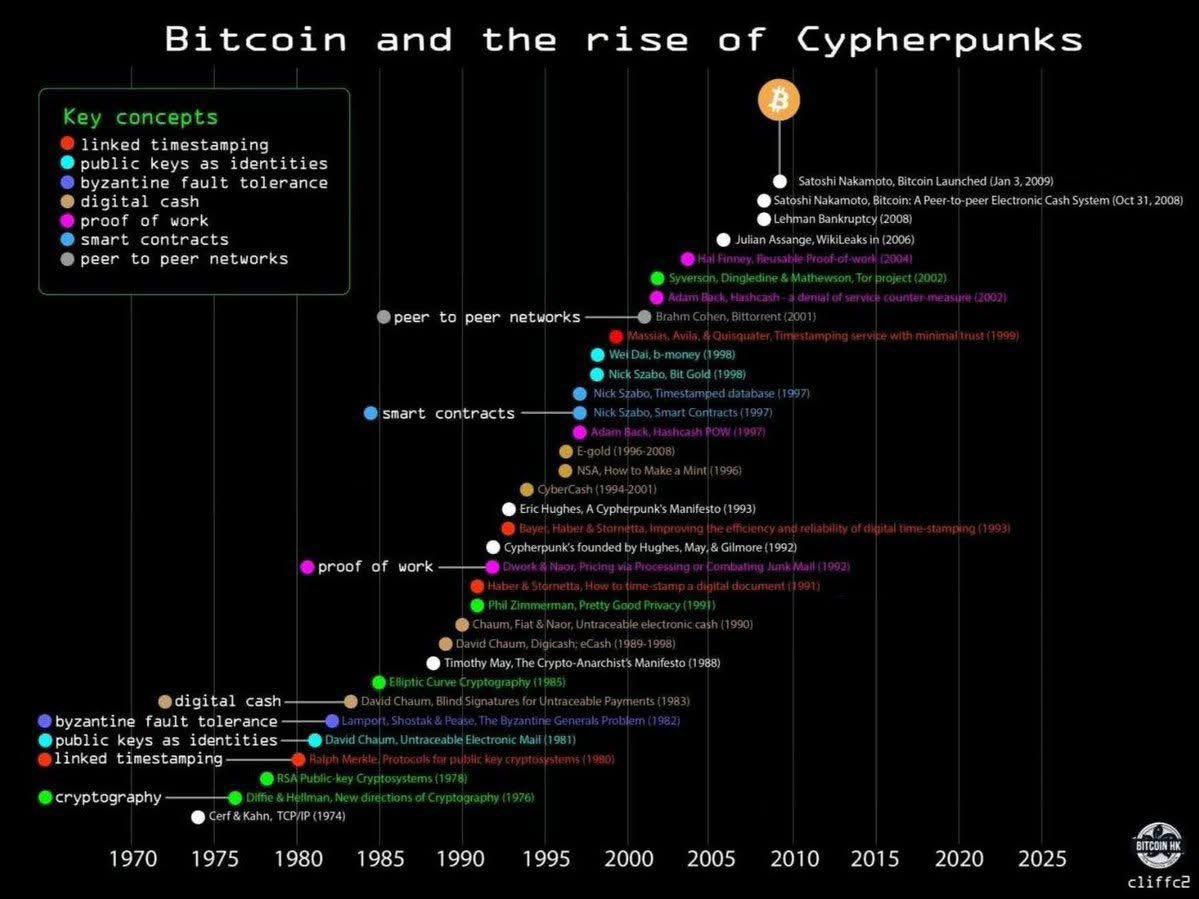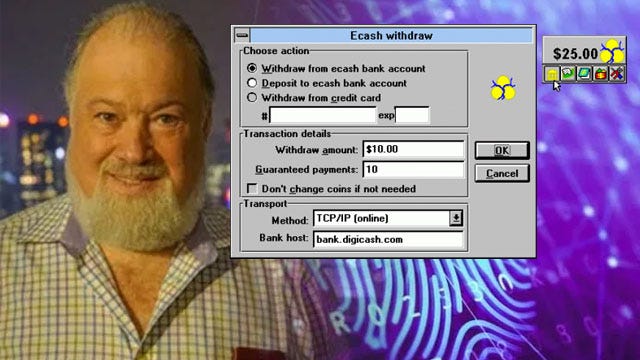Bitcoin and the Rise of Cypherpunks: A Historical Timeline
Bitcoin was 40+ years in the making.
Post sponsored by Bull Bitcoin, the best Bitcoin only Exchange. Buy & Sell Bitcoin, DCS + pay your bills with Bitcoin.
The evolution of Bitcoin and the underlying principles of the cypherpunk movement represent a fascinating intersection of cryptography, decentralized technology, and a vision for privacy and freedom in the digital age.
The timeline below, derived from an insightful infographic, traces the key milestones from the 1970s to the present day, highlighting the development of concepts that culminated in the launch of Bitcoin on January 3, 2009.
Let’s explores each milestone, weaving together the technical innovations and ideological currents that shaped this transformative journey.
1974: Gerf Kahn, TCP/IP
The foundation of the internet era began with the development of the Transmission Control Protocol/Internet Protocol (TCP/IP) by Vint Cerf and Bob Kahn.
This networking framework enabled the reliable transmission of data across distributed systems, laying the groundwork for future innovations in digital communication and decentralized technologies.
1976: Diffie & Hellman, New Directions of Cryptography
Whitfield Diffie and Martin Hellman revolutionized cryptography with their paper New Directions in Cryptography.
They introduced the concept of public-key cryptography, allowing secure communication without prior exchange of secret keys.
This breakthrough became a cornerstone for digital privacy and security.
1980: Ralph Merkle, Protocols for Public Key Cryptosystems
Ralph Merkle expanded on public-key cryptography with his work on protocols for public key cryptosystems.
His contributions, including the concept of Merkle trees, enhanced the efficiency and security of digital signatures, influencing later cryptographic applications.
1982: Lamport, Shostak & Pease, The Byzantine Generals Problem
Leslie Lamport, Robert Shostak, and Marshall Pease tackled the "Byzantine Generals Problem," a model for achieving consensus in the presence of faulty or malicious actors in a distributed system.
This concept of Byzantine fault tolerance became critical for designing robust peer-to-peer networks.
1983: David Chaum, Blind Signatures for Untraceable Payments
David Chaum, a pioneer of digital privacy, introduced blind signatures, a cryptographic technique that enables untraceable payments.
This innovation laid the early theoretical foundation for digital cash systems, emphasizing anonymity and security.
1985: David Chaum, eCash
Building on his earlier work, Chaum developed eCash, one of the first proposals for a digital currency system.
eCash aimed to provide a secure, anonymous alternative to traditional money, reflecting the cypherpunk ethos of individual financial sovereignty.
1988: Timothy May, The Crypto Anarchist Manifesto
Timothy May’s "Crypto Anarchist Manifesto" articulated a vision where cryptography could protect privacy and challenge centralized authority.
This ideological manifesto inspired the cypherpunk movement, advocating for decentralized systems to empower individuals.
1991: Haber & Stornetta, How to Time-Stamp a Digital Document
Stuart Haber and W. Scott Stornetta published a seminal paper on time-stamping digital documents, ensuring their integrity and authenticity.
Their work on linked timestamping became a precursor to blockchain technology.
1991: Eliptic Curve Cryptography
The introduction of elliptic curve cryptography (ECC) provided a more efficient method for public-key cryptography.
This advancement enhanced the security of digital systems and was later adopted in Bitcoin’s cryptographic framework.
1992: Dwork & Naor, Pricing via Processing or Combatting Junk Mail
Cynthia Dwork and Moni Naor proposed a proof-of-work concept to combat spam by requiring computational effort. This idea, initially aimed at email filtering, would later evolve into a key mechanism for securing blockchain networks.
1993: Cypherpunks Founded by Hughes, May & Gilmore
The Cypherpunks, founded by Eric Hughes, Timothy May, and John Gilmore, emerged as a group dedicated to using cryptography to protect privacy and resist surveillance.
Their mailing list and activism fostered a community that drove many subsequent innovations.
1996: NSA, How to Make a Mint
The National Security Agency (NSA) explored the creation of a digital currency in a report titled "How to Make a Mint."
This early governmental interest in digital money highlighted the growing recognition of its potential.
1997: Nick Szabo, Smart Contracts
Nick Szabo introduced the concept of smart contracts, self-executing agreements with terms written in code.
This idea prefigured decentralized applications and played a role in shaping blockchain’s future capabilities.
1997: Adam Back, Hashcash PoW
Adam Back developed Hashcash, a proof-of-work system designed to limit email spam by requiring computational effort.
Hashcash’s proof-of-work mechanism became a direct precursor to Bitcoin’s mining algorithm.
1998: Wei Dai, b-money
Wei Dai proposed b-money, a decentralized digital currency system that used proof-of-work and allowed anonymous transactions.
This concept influenced Satoshi Nakamoto’s design of Bitcoin.
1998: Nick Szabo, Bit Gold
Nick Szabo’s Bit Gold was another early attempt at a decentralized currency, using proof-of-work and a distributed timestamp server. It shared similarities with Bitcoin and demonstrated the growing interest in cryptographic money.
Bit gold was never implemented, but has been called “a direct precursor to the Bitcoin architecture.”
2001: Bram Cohen, BitTorrent
Bram Cohen’s creation of BitTorrent showcased the power of peer-to-peer networks for file sharing.
This technology underscored the potential of decentralized systems, aligning with cypherpunk ideals.
2004: Hal Finney, Reusable Proof-of-Work
Hal Finney enhanced Adam Back’s Hashcash with reusable proof-of-work, allowing computational effort to be reused across transactions. This innovation brought the concept closer to practical use in a currency system.
2006: Julian Assange, WikiLeaks
Julian Assange launched WikiLeaks, a platform for whistleblowers to anonymously leak sensitive documents. This event highlighted the need for secure, censorship-resistant communication, resonating with cypherpunk principles.
2008: Lehman Bankruptcy
The Lehman Brothers’ bankruptcy in 2008 triggered a global financial crisis, eroding trust in traditional banking systems. This event is often cited as a catalyst for the demand for decentralized alternatives like Bitcoin.
October 31, 2008: Satoshi Nakamoto, Bitcoin: A Peer-to-Peer Electronic Cash System
Satoshi Nakamoto published the Bitcoin whitepaper, "Bitcoin: A Peer-to-Peer Electronic Cash System."
This document outlined a decentralized currency using blockchain, proof-of-work, and peer-to-peer networks, marking the birth of modern cryptocurrency.
January 3, 2009: Satoshi Nakamoto, Bitcoin Launched
Bitcoin was officially launched by Satoshi Nakamoto with the mining of its genesis block.
This date marked the practical realization of decades of cryptographic and cypherpunk innovation.
Conclusion
The timeline from the 1970s to 2009 illustrates a gradual convergence of cryptographic techniques, decentralized network designs, and a philosophical drive for privacy and autonomy.
From the early work of Diffie and Hellman to Satoshi Nakamoto’s groundbreaking Bitcoin, each milestone built upon the last, culminating in a technology that challenges traditional financial systems.
The cypherpunk movement, with its emphasis on individual empowerment through cryptography, played a pivotal role in this evolution.
Bitcoin and its underlying principles continue to inspire innovations in the blockchain space, reflecting the enduring legacy of this remarkable journey.
Infographic credit: clifff2
Post sponsored by Bull Bitcoin, the best Bitcoin only Exchange. Buy & Sell Bitcoin, DCS + pay your bills with Bitcoin.











In my book, the cypherpunks make an entrance in the final battle.